In 2013 I traveled around the world for 9 months and wrote a giant packing post explaining exactly what I brought with me. But I definitely overpacked for that trip, and I made better decisions when prepping to spend 4.5 months in Africa. In fact, the reason I know I did a better job packing is that I brought the same amount of luggage, but this time I squeezed in a bulky sleeping bag. That item would not have fit into my 2013 roller bag!
This is EVERYTHING I packed for Africa:
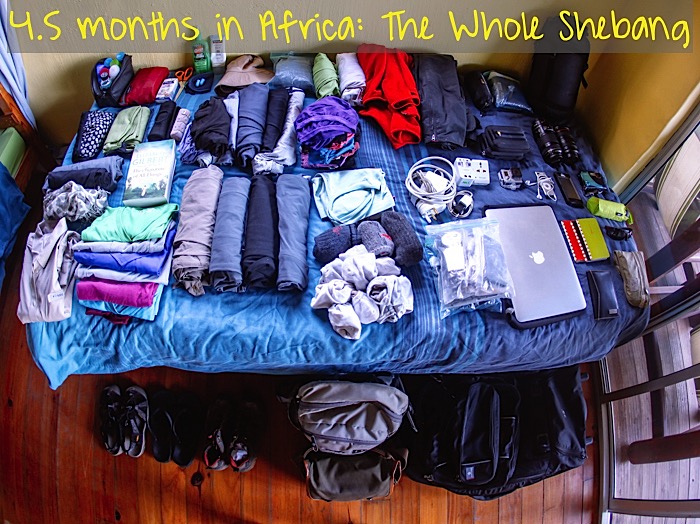
And here’s a more detailed look at those items:
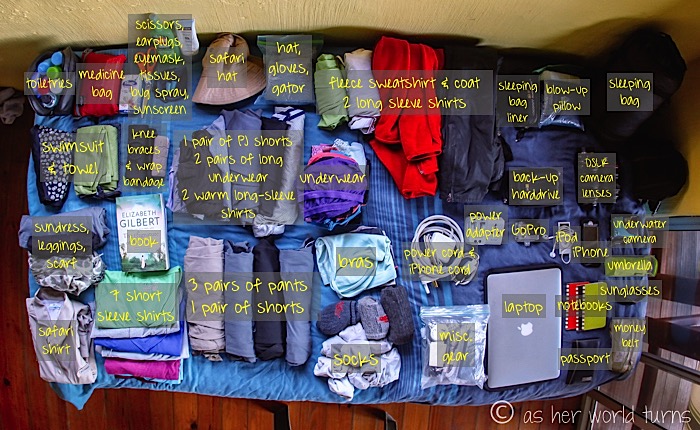
Now let’s dig into specifics…
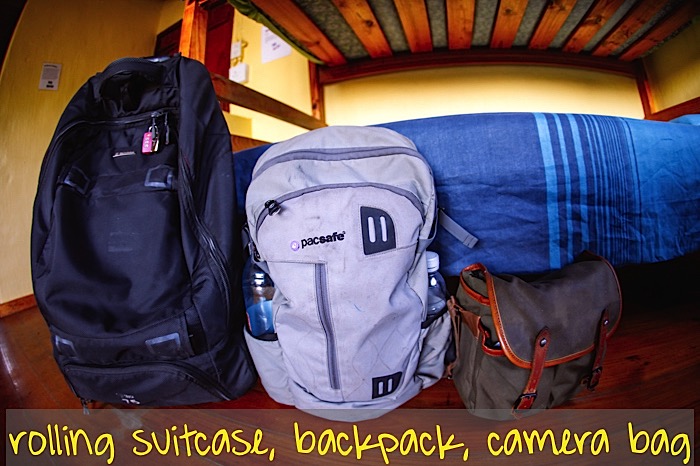
I settled on three bags, the same I carried around the world in 2013:
- Caribee Fast Track 75 rolling suitcase, which can also be used as a backpack but I have yet to try that because it’s too much weight for my poor back. This roller bag has treated me so well over the years — I’ve overstuffed it, dragged it across sand and cobblestone, pulled it up and down stairs — it always puts up with my abuse. This bag is currently unavailable on Amazon but maybe it can be found elsewhere on line? I paid $170 for it in early 2013.
- Pacsafe Luggage Venturesome 25l Daypack, which holds my laptop and electronic or miscellaneous items. It’s got metal meshing and other security features to deter pick-pocketers. I love it and have used it almost daily since making the purchase in 2012 — it’s been showing wear and tear for awhile; I’m due for a replacement soon. It’s been unavailable on Amazon for the last year but there are newer Pacsafe backpacks available… perhaps it will go on my Xmas list.
- MochiThings camera bag, a thoughtful gift from my Y&R co-workers before I left on my big trip. It holds my heavy camera body plus three lenses. Just recently the strap started to fray where it attaches to the bag, but I took care of that with a $10 visit to the shoe repair shop — they had heavy thread and were able to reinforce it so I can get a few more years out of this durable bag. I love it because it holds exactly what I need without being too bulky — the next size up (of any camera bag I considered pre-trip) is way bigger. It’s the Goldie Locks of camera bags — it’s not too big or too small; it’s just right.
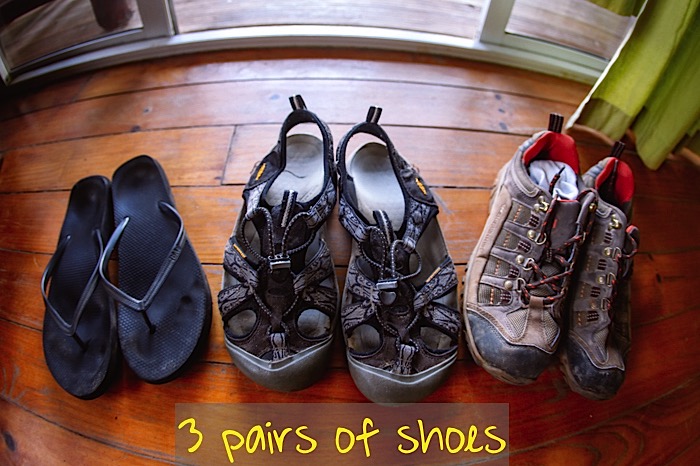
I carefully selected three pairs of shoes for this trip:
- Cheap black flip flops from GAP — perfect for the shower or beach.
- Keen sandals that breathe really well since the sides and back are open — they’ve got the support of sneakers with the breathability of sandals. The only downside is that my feet often stink after a long day of wearing these, as there are no socks to absorb the sweat / odor. I wore these almost every day of the trip and couldn’t wait to wash my feet at night. But they are so comfortable. I’ve since purchased a replacement pair as I owned these for almost five years.
- Hiking boots, purchased for $30 in a Nairobi mall the day before I flew to Kilimanjaro. Pro tip: don’t break in a new pair of shoes before hiking a major mountain! But I had no choice as my decade-old hiking boots from LL Bean bit the dust — literally, the heel started disintegrating — days before Kilimanjaro. Luckily this pair did the trick. I’ve since replaced them with these Keen Women’s Voyager hiking boots, which I love and wear on a daily basis.
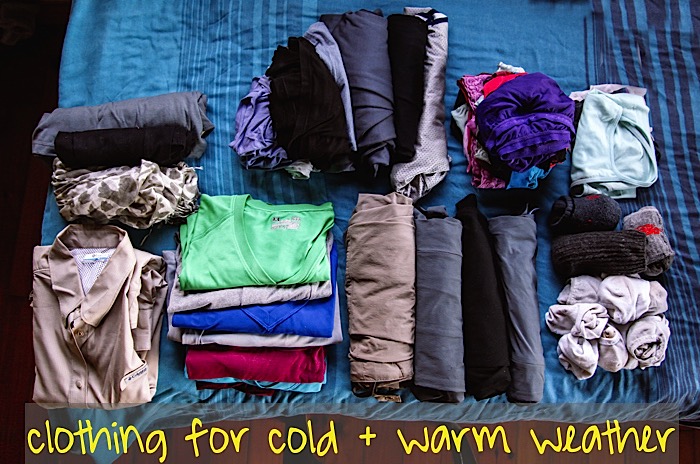
And now for the clothes…
- This was a challenge because I needed high-quality threads for cold nights on Kilimanjaro — I’m talking fleece-lined long underwear and base layer turtlenecks from Uniqlo, both of which I’d purchased for Everest Base Camp last year. While hiking Kili was only 7 days out of my whole trip, I still had to make space in my luggage for those layers. There were a handful of other cold nights on the trip where I was glad to have warm clothes.
- My travel uniform is a pair of neutral pants (I like the convertible kind where the legs zip off at the knee) and a brightly colored V-neck athletic shirt by Under Armour. I’ve built up quite a supply of them by now, but I had to buy more in neutral colors for Africa because it’s the recommended color for safaris — clothes that are too bright or too dark attract flies, whereas hues of khaki, olive, and beige work best to avoid them. To be honest, I didn’t notice any difference in the amount of flies around me on the days when I wore my bright colored shirts.
- I also purchased a traditional safari shirt — one with long sleeves for sun protection that breathes well and is good for hot weather. Funny story about that shirt — it arrived wrinkly so I asked my mom to iron it the night before I left (because she is really good at using an iron and I am not), and even though the shirt’s tag read “iron on low heat” or something to that effect, the moment that iron touched the shirt it burned a big hole. NOOO!!! My mom felt so bad — even though it was not her fault at all; she had the iron on low as indicated, and it was nice of her to even agree to iron it for me in the first place. Since I was getting on a plane the next day, she very kindly ordered a new shirt that my sister brought to Africa a month later when she met me to hike Kilimanjaro. When all was said and done, I wore that shirt like twice in 4.5 months… way less than I anticipated. It was a comfortable enough shirt, but wearing it made me feel like I was playing the role of safari tourist; I was more at home in my Under Armour v-neck tees.
- Finally, I really dig Exofficio travel underwear — they’re super comfortable for long travel days and meant for quick-drying when I do laundry in the sink at hostels or campgrounds.
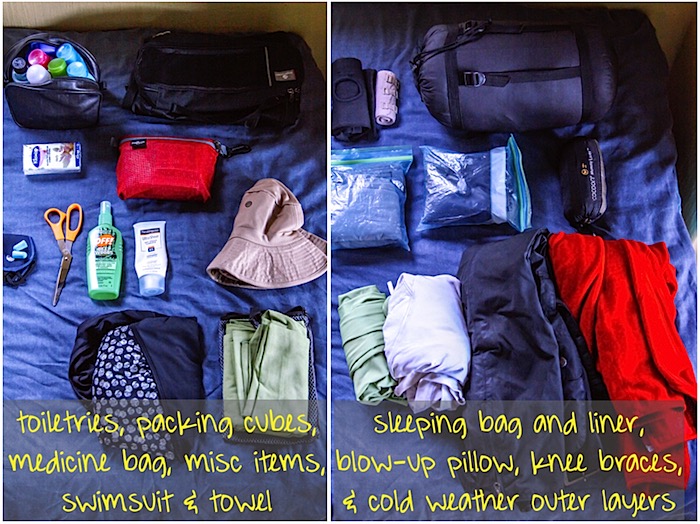
Other necessary gear:
- Toiletries — small bottles of shampoo, conditioner, body wash, and face wash. Plus dental floss, toothpaste, and mouth wash. Nail clippers. Those are my essentials; I didn’t bring any other beauty products. I did pack larger bottles of shampoo and conditioner (maybe 10 oz. each) which I kept inside my rolling suitcase to refill the travel-size bottles as needed.
- Medicine bag — I’ve stocked it with over-the-counter meds, plus a few more my doctor prescribed for the trip. Packing tip: I always take the meds out of their containers and put them in small ziplock bags to save space. I cut out instructions from the original packaging and keep them inside the ziplock bag with their respective pills so I can check directions or active ingredients.
- The common meds I find most helpful are:
- Sleep aids like Ibuprofen PM or Tylenol PM
- Pepto bismol tablets
- Water purification tablets (did not use on this trip)
- Allergy meds
- Antihistamine
- Sudafed
- Immodium AD
- Ibuprofen
- Cough drops
- And the prescription items I carry are:
- Anti-malarials (doxycycline since it’s cheap and I had to take it for months on end, but for shorter trips I prefer Malarone)
- Azithromycin (antibiotics for stomach issues or sinus infections; it fixes a variety of problems)
- Permethrin cream (because I got scabies — ewww! — at the end of my RTW trip last year and now I travel with this cream in case it happens again)
- Altitude medication Diamox (for hiking Kilimanjaro)
- The common meds I find most helpful are:
- Packing cubes — I find them essential for keeping my clothes organized. I have three: one for warm weather clothing, one for cold weather clothing, and one for socks / underwear.
- Scissors — such a necessary item! I bring them everywhere, and they’re so handy on the road. A pair lives in a ziplock bag tucked away in my suitcase.
- Ear plugs and eye mask — completely necessary.
- Sunscreen and bug spray — also very necessary. I reapply sunscreen multiple times per day when traveling.
- Headlamp and small flashlight with spare AAA batteries — for reading in my tent at night or running to the bathroom in the wee hours (no pun intended).
- Safari hat — did not use this nearly as much as I expected. I’m not a hat person, and it made me feel like I was playing the role of tourist, just like my safari shirt.
- Swimsuit and quick-drying towel.
- Sleeping bag — I purchased this one for $40 in Kathmandu last year right before I hiked to Everest Base Camp. It says North Face but I’m pretty certain it’s a knock-off because isn’t as warm as it claims to be. But now it’s seen me through Everest, Kilimanjaro, and 3 months of camping throughout Africa, so it was $40 well spent.
- Silk sleeping bag liner — it’s pricey (around $65 – more than the sleeping bag itself!) but I found it invaluable for overland camping. On hot nights I would sleep on top of my sleeping bag in just the liner. On cold nights I would use it inside my sleeping bag for extra warmth. It was too thin for Kilimanjaro; my sister purchased a fleece sleeping bag liner which kept her much warmer.
- Blow-up pillow — perfect for camping. I added a pillow case from home.
- Knee braces from Target — packed just in case my knees bothered me on Kilimanjaro. I ended up wearing them for the day-and-a-half we hiked downhill. I also brought a wrap bandage in case another ligament (ankle, foot, wrist) gave me trouble; luckily, I didn’t need it.
- Hat, gloves, and gator (which goes around the neck) were invaluable; certainly on Kilimanjaro, but also during other cold nights throughout my trip.
- Cold weather outer layers were key — two long-sleeve wicking shirts, one red fleece sweatshirt from Uniqlo, and my trusty Molly Jacket from Scottevest that I’ve worn for years (it’s got a dozen pockets for convenience and to avoid pick-pocketing — that company has lots of great products). Not photographed: my jacket shell that I wore on Kilimanjaro; I sent it back to the States with my sister since I didn’t anticipate needing it again after our climb.
- Two spare tote bags (not pictured); these were especially handy on the overland truck because I’d leave my rolling bag inside the locker and just pack whatever I needed for the night inside a tote to bring to my tent.
- Ziplock bags in all sizes — freezer, quart, sandwich, and snack size. They come in handy all the time; I bring maybe five of each with me every time I go on a big trip.
- Bag with miscellaneous stuff — extra memory cards for my camera, spare batteries, GoPro accessories, eye drops, a small roll of duct tape, and more.
- TSA-friedly travel locks for all of my bags. I like the combination locks way better than key locks because the key always gets buried in my pockets.
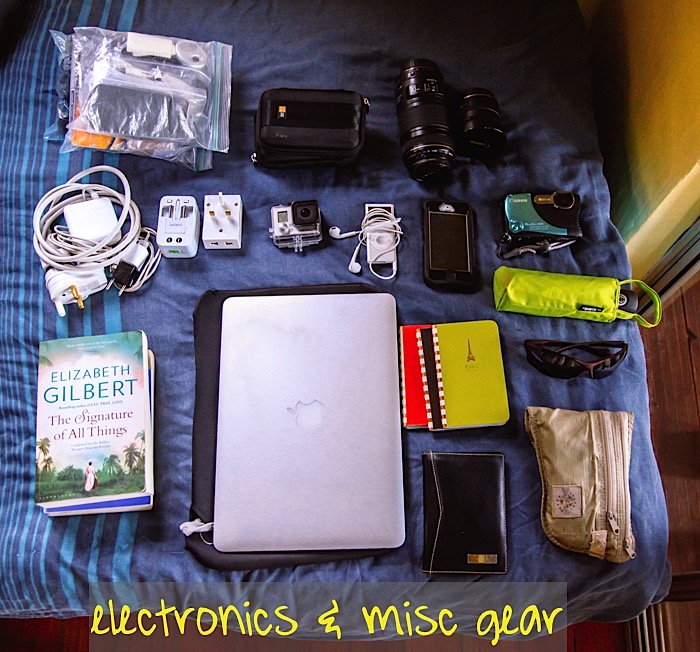
What sort of electronic gear (and other items) made the cut?
- My trusty MacBook Air and power cord. Plus my iPhone and iPod… I’m an Apple girl for life.
- Canon Powershot S100, my small point-and-shoot that I carry in my pocket when I don’t want to bring along my DSLR somewhere. I also use it often to record video.
- GoPro Hero 3+ with underwater housing
- Canon D20 underwater camera, which broke shortly after my shark cage dive. Disappointingly, this one lasted just over a year so I don’t plan on replacing it; for now, I’ll stick with the GoPro for my underwater photography needs.
- Two hard drives, which I keep in separate bags so that if one is stolen then hopefully the other will be safe. I back up my photos every other day or so. I would be fairly devastated if I lost all of my images.
- Multiple converter plugs — most African countries use the same one, but South Africa uses a different kind. Our overland trucks had South African power strips though, so I used that type most of the time in the continent.
- Notebooks to keep track of all purchases, so that I can write accurate expense reports. Someday I’ll switch over to an app but for now the old fashioned pen-and-paper works just fine. I also write down the names of people I meet so that I can reference them later when writing posts for this blog.
- Passport, including Yellow Fever certificate (which is checked at the border of many African countries). I also keep photocopies of my passport and credit cards buried deep inside my rolling suitcase just in case something happens to my passport or money belt.
- Pair of sunglasses, which I used daily. Umbrella, which I never used.
- I read lots of books while traveling (more about that here); I would often swap them out at hostels or campsites that had a take-one, leave-one book policy.
- My DSLR camera body with three lenses, as described below.
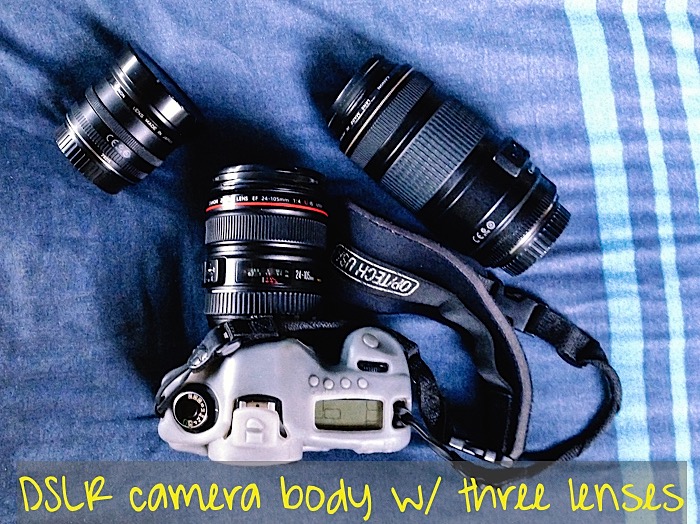
I narrowed it down to three lenses for this trip:
- 24-105mm Canon lens, my trusty sidekick
- 15mm Canon fisheye, my favorite lens of all time
- 70-300 Canon lens, a zoom necessary for African wildlife
I knew I had to purchase a zoom lens for Africa. I would have LOVED to splurge on a better lens but ultimately opted for a much cheaper one — $370 instead of $1,500 or more. (For some reason Amazon currently lists the model I bought for $650 — don’t pay that much!) It was a tough call because most photographers would have gone with a higher quality lens: one with more reach, image stabilization, and a lower f-stop range that performs better in low light. But for a few key reasons I went cheap on the zoom lens. First, I didn’t expect to use it much beyond this trip. While I knew it would get heavy use photographing wildlife in Africa, I couldn’t justify the cost knowing that afterwards it would spend most of its life tucked away in my gear bag at the floor of my closet. Second, the expensive lens that I had my eye on was HUGE; it would have drawn attention everywhere I went and possibly become a target for theft. A bigger lens also means that human subjects can spot me easier, so I can’t fly under the radar. And the bigger lens would not fit into my camera bag so I’d have to buy a new bag (over $100) or sacrifice the space of another lens. Third, the price was just too much; I could travel another couple of weeks if I bought the cheap lens. So after mulling it over I made my decision: for $370 I could take zoom photos of wildlife on a smallish, affordable lens. Sold.
If you haven’t seen my DSLR camera before (pictured above), that grey skin is called Camera Armor and I get asked about it all the time in person. It’s not waterproof but it makes my DSLR a little more durable. I bought its strap on-line to replace the Canon one that comes with the camera; it’s got more padding so it’s comfy around my neck, and I like that it doesn’t say Canon — I think it makes me a little less of a mark, although the attention from the camera skin probably makes up for that.
And there you have it — the whole report on what I packed for Africa! On my 2013 RTW trip I felt like I overpacked, but this time I felt good about everything that made the cut. What do you think — did I leave out any key items that you’d recommend? Or did I pack things you’d find unnecessary?

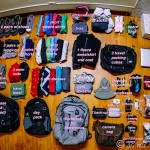

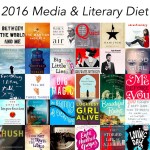



Very impressive !!
Thank you, Mr. Wing!